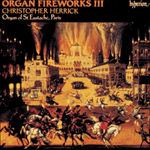
Welcome to Hyperion Records, an independent British classical label devoted to presenting high-quality recordings of music of all styles and from all periods from the twelfth century to the twenty-first.
Hyperion offers both CDs, and downloads in a number of formats. The site is also available in several languages.
Please use the dropdown buttons to set your preferred options, or use the checkbox to accept the defaults.

On completion of the Improvisations and before their first public performance Saint-Saëns went with Périlhou to the organ of the Temple de l’Étoile to play through them. The church’s organist, Alexandre Cellier, recalled in 1954 how Saint-Saëns had remarked on this occasion how enjoyable it was to play the organ; a comment he would scarcely have made in the years between 1878 and 1891. Whilst it would not be at all surprising to find the Op 150 set dedicated to Périlhou, it was in fact Gigout that received their dedication. Gigout, another of his Neidermeyer friends, was regarded by Saint-Saëns as one of the finest improvisers of his generation. Périlhou had retired in 1914 and as Gigout had been professor of organ at the Paris Conservatoire since 1911, where he included Saint-Saëns’ works among the repertoire, it seems at least possible that the set was intended to have some didactic value. Three of the set are titled and use plainchant themes. ‘Feria Pentecostes’ is based on the first hymn of Lauds for Pentecost, Beata nobis gaudia; ‘Pro martyribus’ employs three phrases from the Offertory of the Mass for a martyr, Gloria et honore coronasti eum; ‘Pro defunctis’ quotes from the Offertory of the Requiem, Domine Jesu Christe. It is interesting to note that in these movements Saint-Saëns colours his harmony with the mixolydian or aeolian modes whilst in the freely written pieces his language is more contemporary. Not since the Messe, Op 4, and the Six Duos, Op 8, had he used chant in his written compositions. The first piece is similarly unusual for its ambiguous whole-tone tonality.
from notes by Andrew-John Smith © 2011
Lorsqu’il a eu achevé les Improvisations et avant leur première exécution publique, Saint-Saëns est allé les jouer avec Périlhou sur l’orgue du Temple de l’Étoile. L’organiste de ce temple, Alexandre Cellier, s’est souvenu en 1954 combien Saint-Saëns avait apprécié jouer cet orgue en cette circonstance; il n’aurait probablement pas fait cette remarque entre 1878 et 1891. Il n’y aurait rien eu de surprenant à ce que l’opus 150 soit dédié à Périlhou, mais c’est en fait Gigout qui en fut le dédicataire. Saint-Saëns considérait Gigout, un autre de ses amis de l’École Niedermeyer, comme l’un des meilleurs improvisateurs de sa génération. Périlhou avait pris sa retraite en 1914 et comme Gigout était professeur d’orgue au Conservatoire de Paris depuis 1911, où il incluait des œuvres de Saint-Saëns au répertoire, il semble au moins possible que ce recueil ait été conçu pour avoir une valeur didactique. Trois des improvisations portent un titre et utilisent des thèmes de plain-chant: «Feria Pentecostes» repose sur le premier hymne de Laudes pour la Pentecôte, Beata nobis gaudia; «Pro martyribus» utilise trois phrases de l’offertoire de la messe pour un martyr, Gloria et honore coronasti eum; «Pro defunctis» cite l’offertoire du Requiem, Domine Jesu Christe. Il est intéressant de noter que, dans ces mouvements, Saint-Saëns colore son harmonie avec les modes mixolydien et éolien, alors que dans les pièces écrites librement son langage est plus contemporain. Depuis la Messe, op. 4, et les Six Duos, op. 8, il n’avait plus utilisé le plain-chant dans ses compositions écrites. La première pièce est aussi inhabituelle pour sa tonalité anhémitonique ambiguë.
extrait des notes rédigées par Andrew-John Smith © 2011
Français: Marie-Stella Pâris
 Organ Fireworks, Vol. 3 Organ Fireworks, Vol. 3‘My vote for the best organ record of 1991 … another Herrick/Hyperion marvel’ (Gramophone) ‘Here is something truly spectacular. Hyperion's vivid recording of this magnificent instrument stands out as one of the best recordings of an organ c ...» More |

